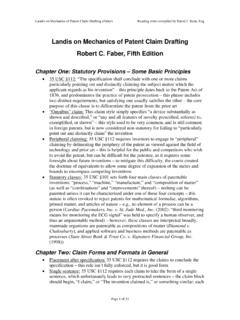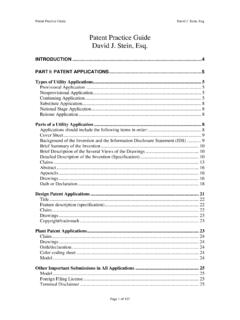Transcription of Landis on Mechanics of Patent Claim Drafting - …
1 Landis on Mechanics of Patent Claim Drafting (Faber) Reading notes compiled by David J. Stein, Esq. Landis on Mechanics of Patent Claim Drafting Robert C. Faber, Fifth Edition Chapter One: Statutory Provisions Some Basic Principles 35 USC 112: The specification shall conclude with one or more claims particularly pointing out and distinctly claiming the subject matter which the applicant regards as his invention this principle dates back to the Patent Act of 1836, and predominates the practice of Patent prosecution this phrase includes two distinct requirements, but satisfying one usually satisfies the other the core purpose of this clause is to differentiate the Patent from the prior art Omnibus Claim .
2 This Claim style simply specifies a device substantially as shown and described, or any and all features of novelty prescribed, referred to, exemplified, or shown this style used to be very common, and is still common in foreign patents, but is now considered non-statutory for failing to particularly point out and distinctly Claim the invention Peripheral claiming: 35 USC 112 requires inventors to engage in peripheral . claiming by delineating the periphery of the Patent as viewed against the field of technology and prior art this is helpful for the public and competitors who wish to avoid the Patent , but can be difficult for the patentee, as it requires some foresight about future inventions to mitigate this difficulty, the courts created the doctrine of equivalents to allow some degree of expansion of the metes and bounds to encompass competing inventions Statutory classes: 35 USC 101 sets forth four main classes of patentable inventions: process, machine, manufacture, and composition of matter.
3 (as well as combinations and improvements thereof) nothing can be patented unless it can be characterized under one of these four concepts this statute is often invoked to reject patents for mathematical formulae, algorithms, printed matter, and articles of nature , no element of a process can be a person (Cardiac Pacemakers, Inc. v. St. Jude Med., Inc. (2002): third monitoring means for monitoring the ECG signal was held to specify a human observer, and thus an unpatentable method) however, these classes are interpreted broadly, manmade organisms are patentable as compositions of matter (Diamond v.)
4 Chakrabarty), and applied software and business methods are patentable as processes (State Street Bank & Trust Co. v. Signature Financial Group, Inc. (1998)). Chapter Two: Claim Forms and Formats in General Placement after specification: 35 USC 112 requires the claims to conclude the specification this rule isn't fully enforced, but it is good form Single sentence: 35 USC 112 requires each Claim to take the form of a single sentence, which unfortunately leads to very protracted sentences the Claim block should begin, I Claim , or The invention claimed is, or something similar; each Page 1 of 32.
5 Landis on Mechanics of Patent Claim Drafting (Faber) Reading notes compiled by David J. Stein, Esq. Claim should also begin with a capital letter and end with a period ( A pencil having a fastener at one end. see Reckendorfer v. Faber (1875)) verb forms should also match throughout the Claim Numbering and order: In design and plant patents, only one Claim is permitted;. utility patents can and usually do have many claims patents with one Claim should not include numbers, but multiple claims should be numbered consecutively MPEP (m): claims should be ordered with the broadest Claim first, and similar claims should be grouped together (a Patent claiming both a process and its product should group the claims to each concept).
6 A horizontal line can be used to separate different groups of claims Numbering during prosecution: When a Claim is canceled in prosecution, its number is not reused, and the others are not renumbered claims added during prosecution are appended to the Claim set, and are given the next highest number when the Patent issues, the USPTO renumbers all claims to produce a consecutive set if a continuation Patent application is filed, the claims in the original Patent should be logically renumbered Preamble: Every Claim should have an introductory section called a preamble . indicating the statutory class of the invention and describing it as a whole.
7 Shorter preambles are preferred (Karsten Mfg. Corp. v. Cleveland Golf Co. (2001): an improved correlated set of iron-type golf-clubs preamble was construed to use correlated as a Claim limitation). Preamble scope: The preamble should be consistent with the scope of the actual Claim , and should be revised if the Claim scope is modified the title of the invention should be similar to the preambles of the claims, but can vary as needed, since the title cannot be read as a Claim limitation an overly broad scope ( an apparatus comprising ) is poor form it's important that the preamble match the invention described in the specification: if the specification calls for a bicycle, the Claim should not specify vehicle.
8 Similarly, if the invention is useful on bicycles or motorcycles, the Claim should not specify bicycle . Preamble limitations: The preamble should not include unnecessary limitations; if a limitation is necessary for the Claim to be patentable, it should be included in the body of the Claim , perhaps in a whereby clause but if the limitation is needed to put the rest of the Claim in proper and understandable context, it can be featured in the preamble composition of matter claims that describe a new and unnamed material may need to include several preamble limitations just to describe it, or may include it as a whereby clause ( a composition having density w and color x, comprising materials y and z.)
9 A composition comprising materials y and z, whereby the composition has density w and color x ) preambles with additional nouns may make the transition ambiguous ( apparatus for shaking articles comprising do the following limitations apply to the apparatus or the articles?); this can be clarified by re-specifying the class ( apparatus for shaking articles, the apparatus comprising ). Preambles in dependent claims: A dependent Claim implicitly, if not explicitly, includes the text of the parent Claim it's incorrect to specify an invention in a dependent Claim that is broader in any aspect than its parent Claim (a Claim to an apparatus for shaking articles should not be referenced by a dependent Claim to Page 2 of 32.
10 Landis on Mechanics of Patent Claim Drafting (Faber) Reading notes compiled by David J. Stein, Esq. an apparatus for holding articles during shaking ; if each aspect is important, Claim them with separate independent claims) more commonly, the dependent just recites the statutory class ( the apparatus of Claim 1, further comprising ). Jepson Claim preamble: A Jepson Claim describes the prior art, before specifying an improvement to it Jepson Claim preambles are usually quite long, and the descriptors of the prior art are always considered limitations and relevant to the scope of the Claim , so accuracy is important USPTO use of preamble: The USPTO relies on the preamble to triage the application to an appropriate examining group, so crafting the claims with this goal in mind is helpful Preamble as Claim limitation.


